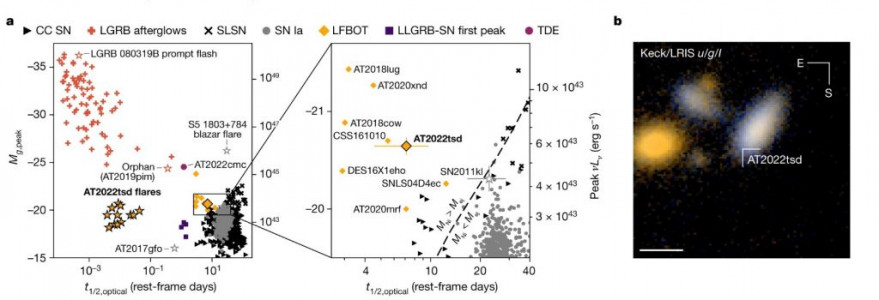After a distant star’s explosive death, an active stellar corpse was the likely source of repeated energetic flares observed by an international team of researchers including Dr Mariusz Gromadzki from the UW’s Astronomical Observatory. The astronomers presented their findings in Nature.
An international team of astronomers have reported on an extraordinary and previously unobserved phenomenon. They analysed energetic flares related to an active stellar corpse, i.e. the rest of the star which had exploded just a few months earlier.
The research was carried out by seventy astronomers, who analysed observation data gathered by means of 15 telescopes. One of them was Dr Mariusz Gromadzki from the Astronomical Observatory of the University of Warsaw. His contribution to the article “Minutes-duration Optical Flares with Supernova Luminosities,” published in Nature, results from the usage of images taken with 3.5m NTT telescope within ePESSTO+ project, in which the UW researcher has been already involved for a few years.
The first author of the publication is Prof. Anna Y. Q. Ho of the Cornell University, USA.
Star explosions
The bright, brief flashes – as short as a few minutes in duration, and as powerful as the original explosion one hundred days later – appeared in the aftermath of a rare type of stellar cataclysm that the researchers had set out to find, known as a luminous fast blue optical transient, or LFBOT.
Since the discovery of the first such phenomenon, the famous “Cow” (AT 2018cow) in 2018, astronomers have speculated about what might drive such extreme explosions, which are far brighter than the violent ends massive stars typically experience, but fade in days instead of weeks. The research team believes the previously unknown flare activity, which was studied by 15 telescopes around the world, confirms the engine must be a stellar corpse: a black hole or neutron star.
Tasmanian devil
The unusual transient was discovered by Zwicky Transient Facility all-sky survey at the beginning of September 2022. It was officially labelled “AT2022tsd” and nicknamed “the Tasmanian devil”, and the ensuing pulses of light were seen roughly a billion light years from Earth. Then, in December 2022, while routinely monitoring the fading explosion, Anna Ho and collaborators Daniel Perley of Liverpool John Moores University, and Ping Chen of the Weizmann Institute of Science in Israel, met to review new observations conducted and analysed by Ping – a set of five images, each spanning several minutes.
The first showed nothing, as expected, but the second picked up light, followed by an intensely bright spike in the middle frame that quickly vanished.
To further investigate the abrupt rebrightening, the researchers engaged partners who contributed observations from more than a dozen other telescopes, including one equipped with a high-speed camera. The team examined earlier data and worked to rule out other possible light sources. Their analysis ultimately confirmed at least fourteen irregular light pulses over a 120-day period, likely only a fraction of the total number.
What processes were exactly at work – perhaps a newly formed compact object (black hole or neutron star) funnelling jets of stellar material outward at close to the speed of light – continues to be studied. In the case of LFBOTs, rapid rotation or a strong magnetic field are probably key components of their launching mechanisms. It is also possible that they are not conventional supernovas at all, instead triggered by a star’s merger with a black hole.



